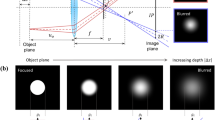Abstract
An advanced background-oriented schlieren (BOS) method, named as the speckle beam-oriented schlieren technique, was newly developed to measure the distribution of refraction angles in transparent media. A speckle pattern is generated by passing a coherent laser beam through a holographic diffuser, a pinhole, and a lens, generating a collimated background image that is projected directly onto the image sensors. Since the intensity of the background image is maintained at a high level, this method is, in principle, useful for diagnosing fast and/or low signal-to-noise phenomena, such as high-temperature gasses with radiation emission. Moreover, by splitting the background beam into two imaging paths with different focal lengths, the refraction angles can be measured for a schlieren object with uncertain location, and the depth position of the refraction angles can be resolved. This technique was demonstrated by measuring the refraction angle and the depth position distribution in a sonic jet with different injected locations.
Graphic abstract















Similar content being viewed by others
Availability of data and material
The datasets analyzed during this study available from the corresponding author on reasonable request.
Abbreviations
- f :
-
Function
- \(f_{\text{even}}\), \(f_{\text{odd}}\) :
-
Even/odd number component of f
- \(f_{\text{L}}\) :
-
Focal length of lens L
- G :
-
Gladstone–Dale constant
- \(I_{i,j}\) :
-
Image
- \(\hat{I}_{i,j}\) :
-
Zero-mean normalized image
- \(I_{{{\text{L}}1}}\), \(I_{{{\text{L}}2}}\) :
-
Images by L1 and L2
- \(I_{\text{raw}}\) :
-
Raw image
- \(i\), \(j\) :
-
Pixel position on image plane
- \(i_{{{\text{L}}1, 0}}\), \(j_{{{\text{L}}1,0}}\) :
-
Reference position for image by L1
- \(i_{{{\text{L}}2, 0}}\), \(j_{{{\text{L}}2,0}}\) :
-
Reference position for image by L2
- \(i_{\text{M}}\), \(j_{\text{M}}\) :
-
Matched position
- \(i_{\text{sub}}\), \(j_{\text{sub}}\) :
-
Sub-pixel estimated position
- \(i_{\text{T}}\), \(j_{\text{T}}\) :
-
Template originated position
- L1, L2 :
-
Lens
- \(l_{\text{pix}}\) :
-
Length corresponding to one pixel
- R i,j :
-
Cross-correlation
- \(T_{m,n}\) :
-
Template image
- \(n_{0}\) :
-
Reference refractive index
- m, n :
-
Pixel position on template image
- \(S_{\text{T}}\) :
-
Template size
- \(\varvec{u}_{{{\text{L}}1}}\), \(\varvec{v}_{{{\text{L}}1}}\) :
-
Vectors for correcting image by L1
- \(\varvec{u}_{{{\text{L}}2}}\), \(\varvec{v}_{{{\text{L}}2}}\) :
-
Vectors for correcting image by L2
- \(x\), \(y\), \(z\) :
-
Coordinates
- \(z_{\text{c}}\) :
-
Correction parameter
- \(z_{\text{eff}}\) :
-
Effective refracted position
- \(z_{\text{jet}}\) :
-
Jet injected position
- \(z_{\text{r}}\) :
-
Position of refraction
- \(z_{\text{s}}\) :
-
Center position of schlieren object
- \(\Delta z\) :
-
Distance between two focal planes
- \(\varvec{\delta}\) :
-
Displacement
- \(\varvec{\delta}_{1}\), \(\varvec{\delta}_{2}\) :
-
Displacement at focal plane of L1, L2
- \(\delta_{1}\), \(\delta_{2}\) :
-
Displacement defined as Eq. (7)
- \(\varvec{\delta}_{{1,{\text{r}}}}\), \(\varvec{\delta}_{{2,{\text{r}}}}\) :
-
Displacement by refraction
- \(\varvec{\delta}_{\text{err}}\) :
-
Error at displacement
- \(\varvec{\varepsilon}\) :
-
Refractive angle
- \(\varvec{\varepsilon}_{\text{ray}}\) :
-
Angle of light ray
- \(\lambda\) :
-
Wavelength
- \(\rho\) :
-
Density
References
Dalziel SB, Hughes GO, Sutherland BR (2000) Whole-field interaction measurements by ‘synthetic schlieren’. Exp Fluids 28:322–335
Di Stefano L, Mattoccia S, Tombari F (2005) ZNCC-based template matching using bounded partial correlation. Pattern Recognit Lett 26(14):2129–2134. https://doi.org/10.1016/j.patrec.2005.03.022
Fomin NA (1998) Speckle photography for fluid mechanics measurements. Springer, Berlin. https://doi.org/10.1007/978-3-662-03707-2
Kawahashi M, Hirahara H (2000) Velocity and density field measurements by digital speckle method. Opt Laser Technol 32(7–8):575–582. https://doi.org/10.1016/S0030-3992(00)00089-X
Kihm KD (1997) Laser speckle photography technique applied for heat and mass transfer problems. Adv Heat Transfer 30:409–439. https://doi.org/10.1017/cbo9780511575013.019
Klemkowsky JN, Fahringer TW, Clifford CJ, Bathel BF, Thurow BS (2017) Plenoptic background oriented schlieren imaging. Meas Sci Technol. https://doi.org/10.1088/1361-6501/aa7f3d
Kuwabara D, Kawasaki H, Iwakawa A, Sasoh A, Yamashita T, Taguchi K (2020) In-tube shock wave compression by piston effect of unsteady jet. Mech Eng J. https://doi.org/10.1299/mej.19-00534
Meier AH, Roesgen T (2013) Improved background oriented schlieren imaging using laser speckle illumination. Exp Fluids. https://doi.org/10.1007/s00348-013-1549-8
Nobach H, Honkanen M (2005) Two-dimensional Gaussian regression for sub-pixel displacement estimation in particle image velocimetry or particle position estimation in particle tracking velocimetry. Exp Fluids 38(4):511–515. https://doi.org/10.1007/s00348-005-0942-3
Raffel M (2015) Background-oriented schlieren (BOS) techniques. Exp Fluids 56(3):1–17. https://doi.org/10.1007/s00348-015-1927-5
Settles GS (2001) Schlieren and shadowgraph techniques. Springer, Berlin. https://doi.org/10.1007/978-3-642-56640-0
Settles GS, Hargather MJ (2017) A review of recent developments in schlieren and shadowgraph techniques. Meas Sci Technol 28(4):aa5748. https://doi.org/10.1088/1361-6501/aa5748
Venkatakrishnan L, Meier GEA (2004) Density measurements using the background oriented schlieren technique. Exp Fluids 37(2):237–247. https://doi.org/10.1007/s00348-004-0807-1
Weinstein LM (2010) Review and update of lens and grid schlieren and motion camera schlieren. Eur Phys J Spec Top 182(1):65–95. https://doi.org/10.1140/epjst/e2010-01226-y
Funding
This work was supported by JSPS Grant-in-Aid for Scientific Research: Grant no. 18H03813.
Author information
Authors and Affiliations
Corresponding author
Ethics declarations
Conflict of interest
We have no conflict of interest.
Code availability
The codes used during this study available from the corresponding author on reasonable request.
Additional information
Publisher's Note
Springer Nature remains neutral with regard to jurisdictional claims in published maps and institutional affiliations.
Rights and permissions
About this article
Cite this article
Nakamura, Y., Suzuki, T., Kinefuchi, K. et al. Speckle beam-oriented schlieren technique. Exp Fluids 62, 13 (2021). https://doi.org/10.1007/s00348-020-03113-3
Received:
Revised:
Accepted:
Published:
DOI: https://doi.org/10.1007/s00348-020-03113-3




